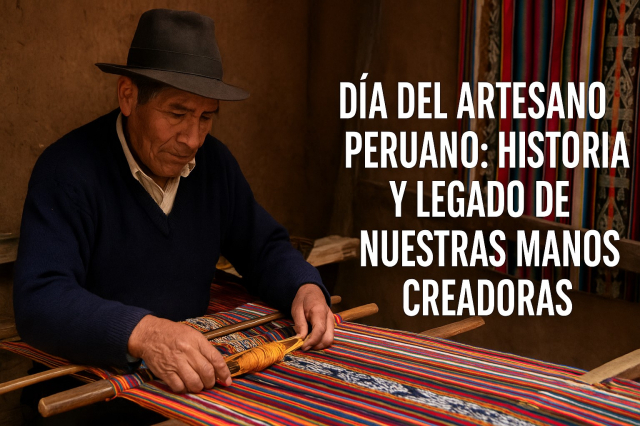Peruvian Artisan Day is celebrated every March 19th , a special date that pays tribute to the men and women who keep the country's cultural heritage alive through their hands. This celebration coincides with Saint Joseph's Day , patron saint of carpenters and a symbol of craftsmanship in many regions of the world.
Handicrafts in Peru are not only an artistic expression , but also an expression of identity, history, and tradition . Each piece—whether ceramic, textile, wood, or metal—tells a story that connects the pre-Columbian past with the present.
👉 You can read more about similar dates in Peruvian Anniversaries and Celebrations to understand how each commemoration strengthens our national identity.
Origin of Peruvian Artisan Day
The date was officially established by the Peruvian government in 1975 , with the aim of recognizing the fundamental role of artisans in the preservation of cultural heritage. Since then, fairs, competitions, and exhibitions have been held throughout the country every March 19th to highlight the creativity and talent of popular artists.
Over the past few decades, the Ministry of Foreign Trade and Tourism (MINCETUR) has promoted policies to formalize and promote artisanal activity , including training programs, quality certification, and access to international fairs.
Craftsmanship as a cultural identity
Regional diversity of Peruvian crafts
Peru is a mosaic of traditions and styles that vary according to region:
Coast: Highlights include totora reed, ceramics, and leather. In Catacaos (Piura), artisans create fine hats and gold and silver filigree.
Sierra: Cusco, Ayacucho and Puno are renowned centers for their textiles, altarpieces and carvings.
Jungle: In regions like Loreto and Ucayali, pieces are made with natural fibers, seeds, and plant dyes, reflecting a deep connection with nature.
Each technique, material, and color is a trace of the ancient civilizations that gave rise to Peruvian art.
If you are interested in learning more about regional festivals and expressions, you can check out Festivals and Traditions of Peru .
Craftsmanship and economy: a silent engine
The artisan as a cultural entrepreneur
Beyond its artistic dimension, crafts are also a vital economic activity . Thousands of Peruvian families depend on this craft, especially in rural and tourist communities.
According to data from MINCETUR (Ministry of Agriculture and Livestock), there are more than 400,000 registered artisans in the country, and many more work independently. At fairs such as Ruraq Maki (Handmade) or the Cusco and Ayacucho Craft Fairs , local products are sold both nationally and internationally.
The current challenge is for Peruvian artisans to be recognized as cultural entrepreneurs , with access to digital tools, marketing training, and sustainable sales channels.
Fairs and celebrations for Craftsman's Day
Every year, various regions of Peru organize fairs and activities to celebrate this date:
Cusco: Folk art exhibition in Plaza San Blas, where master ceramists, weavers, and carvers gather.
Ayacucho: Exhibition of altarpieces, quinoa ceramics, and textile art with workshops open to the public.
Lambayeque: Craft fair in Monsefú, famous for its palm straw and embroidery.
Lima: Kennedy Park and Campo de Marte become showcases of popular art with musical performances and live demonstrations.
These activities not only promote the sale of products, but also pride in our roots and the transmission of knowledge to new generations.
The role of women in Peruvian crafts
In many communities, women artisans are the guardians of ancestral knowledge . They preserve the spinning, weaving, and embroidery techniques inherited from their grandmothers, while also contributing to the economic support of the household.
In regions like Huancavelica, Cajamarca, and Puno , family workshops are led by women who combine art, tradition, and resilience. The inclusion of their work in national fairs has strengthened their independence and visibility.
Peruvian crafts in the world
Peruvian handicrafts are internationally appreciated for their quality and authenticity. The Ayacucho altarpiece , Cusco textiles , Chulucanas ceramics , and Huancayo carved gourds are some examples recognized outside the country.
International fairs such as those in Madrid, Paris, and New York often feature Peruvian artisans who export not only objects, but also stories and symbols of national identity .
Current challenges for Peruvian artisans
Despite the recognition, artisans face several challenges:
Limited access to digital markets and technological tools .
Unfair competition with industrialized or imported products.
Lack of sustained support for business training .
Low visibility in media and tourism platforms.
The solution lies in promoting the digitalization of the sector, fostering sustainable cultural tourism , and ensuring respect for the intellectual property of handcrafted works.
Craftsman's Day in modern times
Today, Artisan Day is celebrated not only with fairs but also with digital campaigns that highlight the value of handmade work.
Social media, especially Instagram and TikTok , has opened up new opportunities to showcase creative processes, inspire young people, and generate direct sales.
The message of this date goes beyond a tribute: it is an invitation to revalue what is made in Peru , support local consumption, and understand that behind each piece there is a story of struggle, art, and culture.
